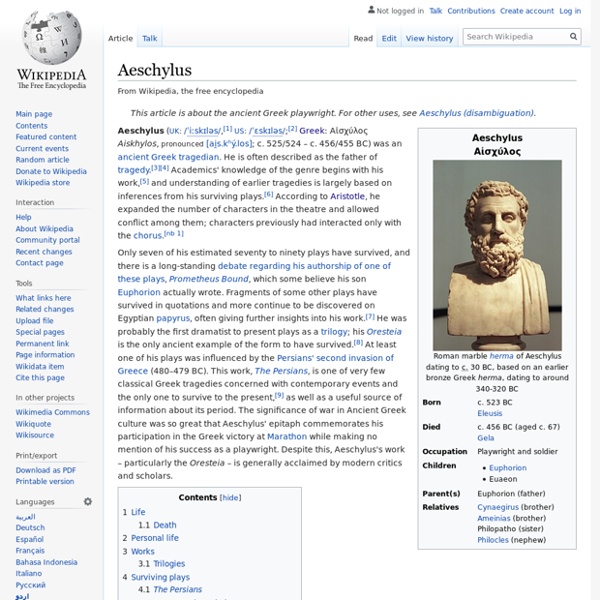Danaïdes
mythical characters Mythology[edit] Danaus did not want his daughters to go ahead with the marriages and he fled with them in the first boat to Argos, which is located in Greece near the ancient city of Mycenae. Danaus agreed to the marriage of his daughters only after Aegyptus came to Argos with his fifty sons in order to protect the local population, the Argives, from any battles. The daughters were ordered by their father to kill their husbands on the first night of their weddings and this they all did with the exception of one, Hypermnestra, who spared her husband Lynceus because he respected her desire to remain a virgin. Danaus was angered that his daughter refused to do as he ordered and took her to the Argives courts.
Keroessa
Story[edit] According to the historian Hesychius of Miletus,[3] as Io, changed into a heifer and being chased by a gadfly on behalf of the jealous Hera, was passing through Thrace, she gave birth to a girl, Keroessa, on the banks of the Golden Horn, by the altar of the nymph Semestra. Keroessa was reared by Semestra and grew up surpassing other local maidens in beauty. She had intercourse with Poseidon and in due course gave birth to a son, whom she named Byzas. He became the founder of Byzantium and named the Golden Horn (Greek Χρυσόκερας) after his mother.
Juno
From Wikipedia, the free encyclopedia Jump to navigationJump to search Juno could mean: Music[change | change source] Vehicles[change | change source]
Juno
From Wikipedia, the free encyclopedia Jump to navigationJump to search Juno may refer to:
Britannica
Mercury, Latin Mercurius, in Roman religion, god of shopkeepers and merchants, travelers and transporters of goods, and thieves and tricksters. He is commonly identified with the Greek Hermes, the fleet-footed messenger of the gods. The cult of Mercury is ancient, and tradition has it that his temple on the Aventine Hill in Rome was dedicated in 495 bce.
Mercury
Mercury usually refers to: Mercury may also refer to: Arts and entertainment[edit] Characters[edit]
Argus Panoptes
Mythology[edit] And set a watcher upon her, great and strong Argus, who with four eyes looks every way. And the goddess stirred in him unwearying strength: sleep never fell upon his eyes; but he kept sure watch always. According to Ovid, to commemorate her faithful watchman, Hera had the hundred eyes of Argus preserved forever, in a peacock's tail.[10][11] Eponyms[edit]
Mycenae
Archaeological site in Greece Mycenae ( my-SEE-nee;[2] Ancient Greek: Μυκῆναι or Μυκήνη, Mykē̂nai or Mykḗnē) is an archaeological site near Mykines in Argolis, north-eastern Peloponnese, Greece. It is located about 120 kilometres (75 miles) south-west of Athens; 11 kilometres (7 miles) north of Argos; and 48 kilometres (30 miles) south of Corinth. The site is 19 kilometres (12 miles) inland from the Saronic Gulf and built upon a hill rising 900 feet (274 metres) above sea level.[3] In the second millennium BC, Mycenae was one of the major centres of Greek civilization, a military stronghold which dominated much of southern Greece, Crete, the Cyclades and parts of southwest Anatolia. The period of Greek history from about 1600 BC to about 1100 BC is called Mycenaean in reference to Mycenae.
Ortygia
Ortygia (; Italian: Ortigia; Greek: Ὀρτυγία) is a small island which is the historical centre of the city of Syracuse, Sicily. The island, also known as the Città Vecchia (Old City), contains many historical landmarks. The name originates from the ancient Greek ortyx (ὄρτυξ), which means "Quail".
The Fountain of Diana in Syracuse and Arethusa’s metamorphosis
At the center of the fountain he created in Syracuse, Giulio Moschetti (1847-1909) portrayed Diana, the goddess of the hunt, in all of her calm and pride. At her feet, Alpheus looks on in amazement as his beloved Arethusa turns into a fountain: appalled by the river god’s erotic pursuit, the nymph had asked for Diana’s help, leading to her metamorphosis. She sunk into the ground and emerged on the island of Ortygia, the oldest part of the Sicilian city. According to legend, that is the origin of the spring named after Arethusa. The reinforced concrete sculpted group in Piazza Archimede also includes Tritons and Pistrices, and was built between 1906 and 1907.
Ortigia: Utterly Mythical
Ortigia, the island off the coast of Syracuse in Sicily (Italy) is as Strabo wrote ‘utterly mythical’. It is one of the principal candidates for the location of the birthplace of Leto’s twins, Apollo and Artemis. It is home to a Roman Catholic Duomo (Cathedral) within which is encased a complete temple to the warrior goddess Athena; as well as the spectacular ruins of one of the most ancient Temples of Apollo and the secretive ruins of an Artemision, temple to Artemis.
Greek mythology
Arethusa, in Greek mythology, a nymph who gave her name to a spring in Elis and to another on the island of Ortygia, near Syracuse. The river god Alpheus fell in love with Arethusa, who was in the retinue of Artemis. Arethusa fled to Ortygia, where she was changed into a spring.



